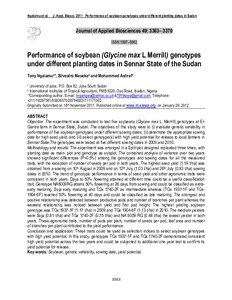| dc.contributor.author | Ngalamu, T. |
| dc.contributor.author | Meseka, S.K. |
| dc.contributor.author | Ashraf, M. |
| dc.date.accessioned | 2019-12-04T11:07:46Z |
| dc.date.available | 2019-12-04T11:07:46Z |
| dc.date.issued | 2012-01 |
| dc.identifier.citation | Ngalamu, T., Meseka, S.K. & Ashraf, M. (2012). Performance of soybean (Glycine max L Merrill) genotypes under different planting dates in Sennar State of the Sudan. Journal of Applied Biosciences, 49, 3363-3370. |
| dc.identifier.issn | 1997-5902 |
| dc.identifier.uri | https://hdl.handle.net/20.500.12478/1581 |
| dc.description | Published online: 29 Jan 2012 |
| dc.description.abstract | Objective: The experiment was conducted to test five soybeans (Glycine max L. Merrill) genotypes at El-Gantra farm in Sennar State, Sudan. The objectives of this study were to (i) evaluate genetic variability in
performance of five soybean genotypes under different sowing dates; (ii) determine the appropriate sowing date for high seed yield; and (iii) select genotype(s) with high yield potential for release to local farmers in
Sennar State.The genotypes were tested at five different sowing dates in 2009 and 2010.
Methodology and results: The experiment was arranged in a Split-plot designed replicated three times, with
planting date as main- plot and genotype as subplot. The combined analysis of variance over two years
showed significant differences (P<0.5%) among the genotypes and sowing dates for all the measured
traits, with the exception of number of seeds per pod in both years. The highest seed yield (1.19 t/ha) was
obtained from a sowing on 10th August in 2009 and on 12th July (1.03 t/ha) and 26th July (0.93 t/ha) sowing
dates in 2010. The trend of genotypic performance in terms of seed yield and other agronomic traits were
consistent in both years. Days to 50% flowering attained at different time could be a useful classification
trait. Genotype NA5009RG attains 50% flowering at 28 days from sowing and could be classified as extra-
early maturing, Soja early maturing and TGx 1740-2F as intermediate whereas (TGx 1937-1F and TGx-
1904-6F) reached 50% flowering at 40 days and could be classified as late maturing. The strongest and
positive relationship was detected between productive pods and number of branches per plant whereas the
weakest relationship was noticed between yield and first pod height. The highest yielding soybean
genotype was TGx 1937-1F (1.17 t/ha) in 2009 and TGx 1904-6F (1.13 t/ha) in 2010. The medium yielders
were Soja (0.81 t/ha) and TGx 1740-2F (0.75 t/ha) and NA 5009 RG (0.48 t/ha) the lowest yielder in both
years. These agronomic traits, number of pods per plant, number of seeds per pod, leaf area and number
of branches per plant contributed to the yield performance.
Conclusion and application: These traits could be used as selection indices to select soybean genotypes
with high yield potential. In this study, genotypes TGx 1937-1F and TGx 1740-2F demonstrated consistent
high yield potential across the two years and could be subjected to additional one year test to confirm its
yield potential for release. |
| dc.language.iso | en |
| dc.subject | Soybeans |
| dc.subject | Genotypes |
| dc.subject | Sowing Date |
| dc.subject | Yield Potential |
| dc.subject | Genetic Variability |
| dc.title | Performance of soybean (Glycine max L Merrill) genotypes under different planting dates in Sennar State of the Sudan |
| dc.type | Journal Article |
| dc.description.version | Peer Review |
| cg.contributor.crp | Grain Legumes |
| cg.contributor.affiliation | University of Juba |
| cg.contributor.affiliation | International Institute of Tropical Agriculture |
| cg.coverage.region | Africa |
| cg.coverage.region | East Africa |
| cg.coverage.region | West Africa |
| cg.coverage.country | South Sudan |
| cg.coverage.country | Nigeria |
| cg.authorship.types | CGIAR and developing country institute |
| cg.iitasubject | Soybean |
| cg.iitasubject | Grain Legumes |
| cg.journal | Journal of Applied Biosciences |
| cg.howpublished | Formally Published |
| cg.accessibilitystatus | Limited Access |
| local.dspaceid | 82142 |

